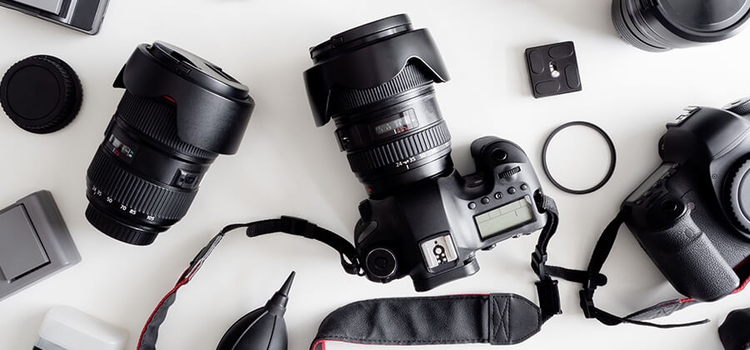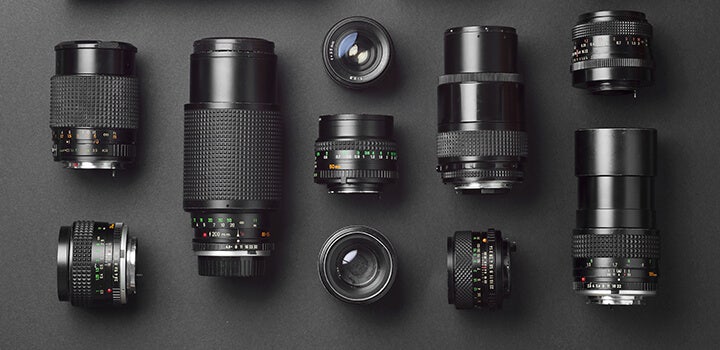Photography
The basics of the DSLR camera.
Explore the pros and cons of using this popular type of digital camera.

JUMP TO SECTION
The advantage of interchangeable lenses
What to know about DSLRs.
When the goal is a flexible shooting experience, the lightweight DSLR camera lets you see what’s happening in the moment. DSLRs pair well with other lenses and attachments, making them photographer favorites. But even with their great autofocus and low light features, they can have exposure discrepancies — which might make using mirrorless cameras a better option.
What is a DSLR camera?
A DSLR camera is a camera that operates with a fixed, digital sensor. It can autofocus and hold thousands of photos on its internal memory card, making it a favorite camera choice for both pros and entry-level photographers alike.
Even though the DSLR (or “digital single-lens reflex”) is a term that’s become synonymous with digital cameras and interchangeable lenses, DSLRs are just one type of digital camera. In fact, there are many. And because of the wide range of equipment available for digital photography, it’s important to understand camera options before making a big purchase.
Explore more about what makes DSLR cameras so popular and find out if they’re the right choice for you.
How a DSLR camera works.
When light enters the camera lens of a digital SLR camera, a photographer sees their subject in the optical viewfinder via a reflection of that light from a mirror inside the camera body. As the photographer snaps the photo, the mirror swings out of the way, and the light goes through to the digital image sensor to capture the photo on an SD card. This is different from mirrorless cameras, where the light goes directly to the image sensor, and the photographer sees what they’re shooting via a rear LCD screen or an electronic viewfinder.
Types of DSLR image sensors.
While different DSLR cameras have different sensor sizes, these sensors are still large enough to capture enough megapixels to blow your smartphone camera image quality out of the water. The two primary sensor types are full-frame and APS-C. Full-frame camera sensors, which match the size of 35mm film, are the standard. APS-C sensors are slightly smaller, resulting in a lower focal length called “crop factor.” You can compensate for this smaller field of view with specific lens attachments, but it’s definitely a difference to keep in mind when researching your ideal APS-C or full-frame DSLR.
The advantage of interchangeable lenses.
DSLR cameras allow you to combine the camera body with lens attachments of your choice, whether that’s a fisheye or a zoom lens. “You’re able to get different types of lenses that serve different purposes and give you different looks,” photographer Ivy Chen explains. “DSLRs are way more versatile in that respect.”
Whether your goal is intimate portrait photography or shooting stunning landscapes, understanding the ideal focal length for each situation will help you select the best lens for going the DSLR route.

A few other DSLR advantages.
Low light: DSLR cameras are very effective for shooting in dim lighting, as the larger sensor can capture more light.
Autofocus: DSLRs have better autofocus features than point-and-shoot cameras, allowing you to focus and shoot faster to capture more high-quality images.
Battery life: DSLRs don’t require the digital screen to be on all the time, so they use very little power, extending battery life.
The disadvantage of DSLRs.
Although taking photos with a digital camera does let you see your image immediately — unlike film which you must develop — often, what a DSLR viewfinder sees isn't the same thing that was exposed to the image sensor. That's because DSLRs rely on the mirror for some of their focus, which can be problematic. The point is — you might not get a good look at exactly what your camera captured until you’re editing your shots.
With a mirrorless camera, you get what you see — the sensor sees the same exposure, allowing you to fine-tune camera adjustments right then and there. While you can still adjust in the moment with DSLR, there may be being more issues to clean up in editing, due to the exposure discrepancy between the viewfinder and the sensor.
When it comes to editing, becoming accustomed to what your DSLR does can come with a learning curve. “Preparing a raw file before retouching or color editing took some adjustment when I moved to digital,” says DSLR photographer Stephen Klise. “All the light and color reacted differently from what I learned — you get a lot of pronounced reds and that was very new for me.”
With Adobe Photoshop Lightroom, there are many ways to edit and enhance your photos, and photo filters to help with your camera’s unique color correction issues.
Adjust light and color: See how to fine-tune white balance, color saturation, and make other tweaks to your photos using Lightroom’s Light panel.
Remove photo tints: You can remove a color cast on a photo, made by the lighting conditions of your shot, in a few quick steps with Lightroom.
Make colors pop: Use the Vibrance and Saturation sliders to increase color intensity in your photos.
Mirrorless or DSLR?

Photographers love DSLR cameras because they're durable, can easily pair numerous lenses and attachments, have a great battery life, and offer higher shooting speeds with better autofocusing. But there is a difference between what photographers see in the viewfinder and what’s in the exposure, an issue they won’t experience with mirrorless cameras.
Both styles typically offer continuous shooting (or burst mode) and image stabilization settings, but mirrorless cameras shine over DSLR when it comes to video recording. The DSLR's mirror makes focusing video difficult, meaning the mirrorless camera can better capture full HD video. Mirrorless cameras are also lighter and more compact, as the camera body needs space for only a sensor instead of a whole mirror system. Gain some insight on mirrorless cameras from music photographer Chad Wadsworth, an early adopter of the camera type.
The best DSLR or camera for you will depend on the subject you intend to shoot and the situation you intend to shoot in. Different DSLR models and lenses offer different benefits, but armed with this knowledge, the search for the right camera for you should be an easier one.